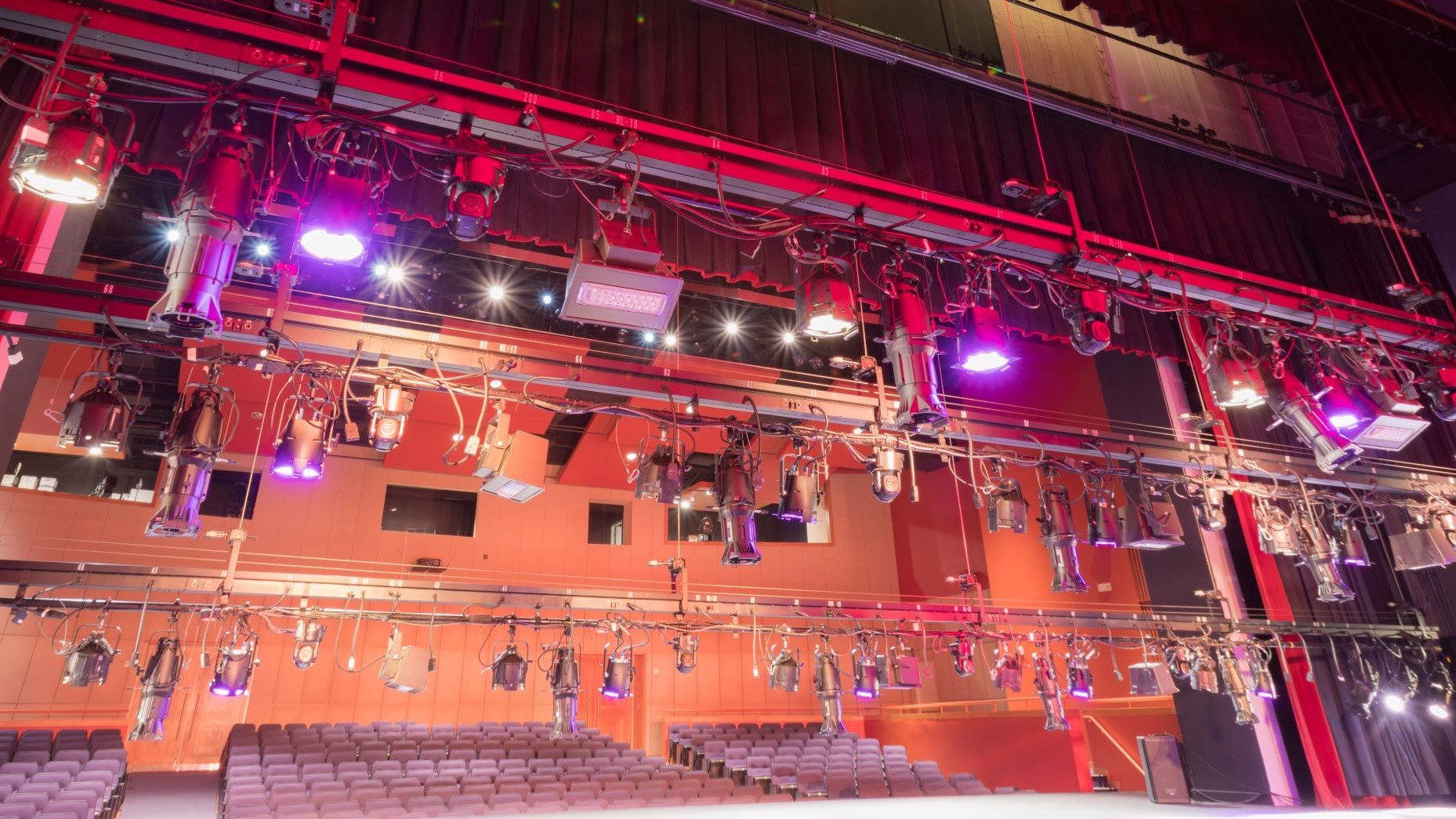Get ready for the next exciting chapter in our stage lighting design series. Building on the foundations laid in Part 1: Introduction to Lighting and Part 2: Objectives of Lighting Design, as well as exploring the intricacies of the Controllable Properties of Light in Part 3, we now turn our attention to the various types of lights that you are likely to encounter.
Types of Lights
Most stage lights that you are likely to encounter will fall into one of these basic categories (in order of complexity):
• Floodlight
• PAR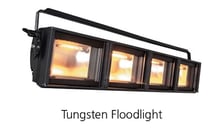 • Fresnel
• Fresnel
• Profile
• Moving light
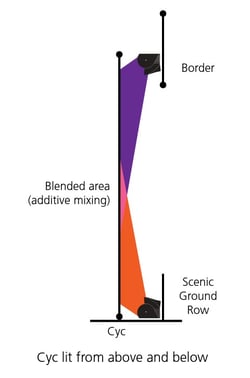 Floodlights
Floodlights
Let’s start by looking at the simplest of the fixtures. Floodlights, as the name suggests, are designed to ‘flood an area with light.’ They are traditionally used to light cyclorama and painted cloths. Floodlights typically consist of a lamp (light source) and a reflector.
There are no lenses in a tungsten floodlight and you have very little control over the size and shape of the beam. Floodlights are designed with an asymmetrical reflector that allows the light to be evenly distributed from the top of the cloth to the bottom. In conventional lighting rigs, floodlights would be rigged and then filters would be used to make them red, green, and blue. Since most floodlights were 4-cell units, the fourth color would usually be amber, open white, or another blue. Of course, floodlights do not have to be colored in red, green and blue. You could choose the filters that would suit the production needs best.
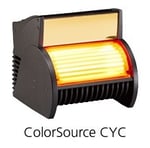 Cycloramas tend to be lit from both above and below and, depending on the type of material used, they can also be lit from behind. Back-lighting a cyclorama, known as a BP or RP (back/rear projection) screen means that you do not have to worry about trying to conceal the light sources. Lighting from both above and below can create some interesting effects and is one of the methods employed when creating the illusion of a sunrise or sunset. LED floodlights are slightly more complex than traditional floodlights in that they do have a lens which has been specially designed to spread the light in a similar fashion, but their purpose and application is the same.
Cycloramas tend to be lit from both above and below and, depending on the type of material used, they can also be lit from behind. Back-lighting a cyclorama, known as a BP or RP (back/rear projection) screen means that you do not have to worry about trying to conceal the light sources. Lighting from both above and below can create some interesting effects and is one of the methods employed when creating the illusion of a sunrise or sunset. LED floodlights are slightly more complex than traditional floodlights in that they do have a lens which has been specially designed to spread the light in a similar fashion, but their purpose and application is the same.
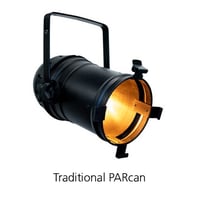 PARs
PARs
PARs (PARcans) have been a staple of stage lighting for years. PAR is an abbreviation for Parabolic Aluminized Reflector and is a reference to the type of lamp used. A PAR is a lamp that has the lens, reflector, and light source in a single sealed beam housing. PARs produce very intense beams of light that are slightly oval. Because the lamps also contain the lens and reflector, the only way to change the size of the beam is to replace the entire lamp – which can be costly. PARs can be used as part of a general cover as they provide bright washes of light 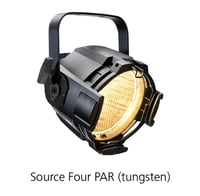 when focused correctly. PARs can be focused by adjusting their position (pan & tilt) and you have a degree of control over the beam by rotating the lamp to adjust the orientation of the oval-shaped beam. PARs can be colored using gels.
when focused correctly. PARs can be focused by adjusting their position (pan & tilt) and you have a degree of control over the beam by rotating the lamp to adjust the orientation of the oval-shaped beam. PARs can be colored using gels.
ETC has its own version of the PAR called the Source Four PAR – this is a single luminaire with a set of interchangeable lenses, making it much easier and more affordable to adjust the size of the beam.
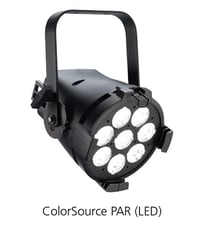 LED PARs have started to replace PAR because they can change color without the need for gels and are safer to use as they do not get hot. You can still change the beam shape and size by using specially designed lenses that are fitted to the front of the fixtures.
LED PARs have started to replace PAR because they can change color without the need for gels and are safer to use as they do not get hot. You can still change the beam shape and size by using specially designed lenses that are fitted to the front of the fixtures.
Fresnel
Pronounced “Fre’nel,” these are the first types of light that offer us some degree of control over 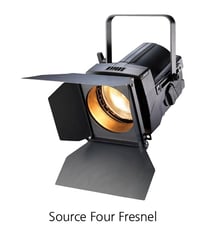 the size and shape of the beam. Fresnels get their name from the inventor of the lens that they use (which were originally designed for use in lighthouses), easily recognizable by the series of concentric rings on the front of the lens. A Fresnel has the capability to adjust the size of the beam from a narrow spot to a wide flood (typically 10° - 55°), making it a versatile fixture that can be used for both general cover as well as for isolating parts of the stage or highlighting certain elements during the show (known as a ‘special’).
the size and shape of the beam. Fresnels get their name from the inventor of the lens that they use (which were originally designed for use in lighthouses), easily recognizable by the series of concentric rings on the front of the lens. A Fresnel has the capability to adjust the size of the beam from a narrow spot to a wide flood (typically 10° - 55°), making it a versatile fixture that can be used for both general cover as well as for isolating parts of the stage or highlighting certain elements during the show (known as a ‘special’).
A Fresnel beam has a very soft edge which makes it easy to blend when creating your general cover and stage washes. You also have the option of adding a ‘barn door’ – an accessory that 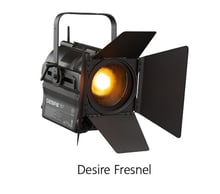 fits to the front of the light (in front of the color) and allows you to shape the light and prevent it from spilling in areas where you do not want it.
fits to the front of the light (in front of the color) and allows you to shape the light and prevent it from spilling in areas where you do not want it.
With a tungsten Fresnel, the lens is in a fixed position, and the lamp and reflector move together to adjust the beam size. The closer the lamp is to the lens, the wider the light, and the further away from the lens, the narrower the beam of light becomes.
The Fresnel has a European cousin called a “PC.” A PC has a Plano-convex lens (hence its name) and operates in a similar fashion. A PC has a more defined edge than a Fresnel, a wider zoom range (6°-60°) and the beam can also be roughly shaped using barndoors.
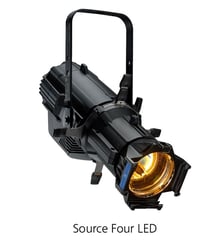 Profile (Ellipsoidal Spot)
Profile (Ellipsoidal Spot)
A profile is named for its ability to project a profile of an image or shape. Profiles (also referred to as ‘ellipsoidals’) are the most complex fixtures optically, but also offer you the most control over the light that they emit. Profiles can project a beam of light that can be either hard- or soft-edged. You can also adjust the size of the beam, either by adjusting the lenses or by using an iris, and you can shape the beam using an internal set of framing shutters. Profiles can also project patterns and add texture to the beam by using a gobo.
There are two main kinds of profiles – ‘fixed beam’ and ‘zoom’ profiles. Fixed beam profiles 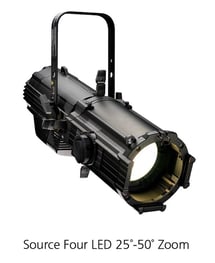 have a beam angle that is predetermined by the lens system. You can change the edge of the beam (hard or soft) but if you want to adjust the size of the beam, you will need an accessory called an iris. There are a number of fixed beam profiles available, the most common being 19°, 26°, 36°, and 50°. You can also get 5°, 10°, 14°, 70°, and 90° variants.
have a beam angle that is predetermined by the lens system. You can change the edge of the beam (hard or soft) but if you want to adjust the size of the beam, you will need an accessory called an iris. There are a number of fixed beam profiles available, the most common being 19°, 26°, 36°, and 50°. You can also get 5°, 10°, 14°, 70°, and 90° variants.
Zoom profiles make use of a pair of independently controlled lenses, and by adjusting these, you can change the size of the beam from a narrow spot to a wide beam. The amount of adjustment that you have depends on the beam angle of the fixture, but typically you will find there are both ‘narrow zoom’ and ‘wide zoom’ options. A ‘narrow’ zoom will allow for adjustment of the beam from 15° to 30° and a wide zoom will allow for a variation from 25° to 50°. You can make further adjustments to the size of the beam using an iris in a zoom profile, too.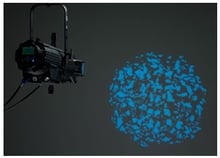
Profiles have a set of four framing shutters that allow for precise shaping of the beam. You can also make use of a gobo to project a pattern (like a window) or just to add a breakup texture to the beam (like a leaf pattern), which can add an additional layer and dimension to your design.
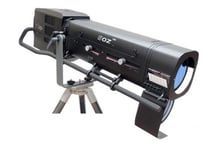 Followspots
Followspots
A followspot is a profile with a really narrow beam angle that is typically focused to produce a hard-edged beam of light used to follow an actor on the stage. You can use a 5° or 10° Source Four with an iris as a followspot too!
Moving lights
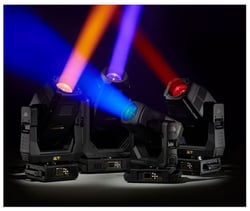 It is not uncommon to find moving lights in our theatres and lighting rigs. There are two categories of moving lights – “spots” and “washes.” Spots behave like profiles and as such would fall into this main category. A moving spot allows you to change color, use gobos, adjust the size and edge of the beam, and some even offer a set of framing shutters for precise beam control. A moving wash light behaves more like a Fresnel (or a PAR on the simpler units). A wash light will offer you the ability to change color, adjust the size of the beam and have a Fresnel-like soft edge. Both washes and spots allow you to control their focus (position) on stage – all of these features can be controlled remotely from the lighting desk.
It is not uncommon to find moving lights in our theatres and lighting rigs. There are two categories of moving lights – “spots” and “washes.” Spots behave like profiles and as such would fall into this main category. A moving spot allows you to change color, use gobos, adjust the size and edge of the beam, and some even offer a set of framing shutters for precise beam control. A moving wash light behaves more like a Fresnel (or a PAR on the simpler units). A wash light will offer you the ability to change color, adjust the size of the beam and have a Fresnel-like soft edge. Both washes and spots allow you to control their focus (position) on stage – all of these features can be controlled remotely from the lighting desk.
If you found this information helpful, don't miss our blog series dedicated to the art of stage lighting design, right here:
Stage Lighting Design, Part 1: Introduction to Lighting
Stage Lighting Design, Part 2: Objectives of Lighting Design
Stage Lighting Design, Part 3: Controllable Properties of Light
Stage Lighting Design, Part 4: Types of Lights
Stage Lighting Design, Part 5: Lighting Angles
Stage Lighting Design, Part 6: Color
Stage Lighting Design, Part 7: Lighting Systems
Stage Lighting Design, Part 8: Planning Your Design
Stage Lighting Design, Part 9: Getting Technical
Stage Lighting Design: Glossary
This blog series is an adaptation of our free digital guide, Stage Lighting Design: An Introduction, based on content written by ETC Outreach and Training Specialist, Declan Randall.
If you enjoyed this post on the subject of various types of lighting fixtures, head over to our website where you can access Stage Lighting Design: An Introduction. As a bonus, you can also download a set of accompanying posters for free! You can also visit etcconnect.com to find out more about the wide variety of lighting fixtures manufactured by ETC.


